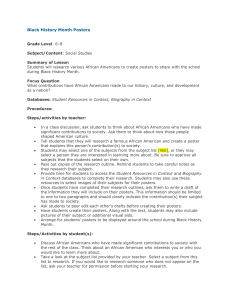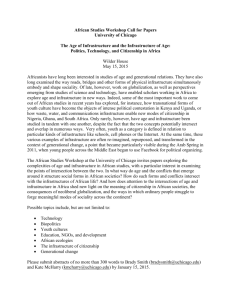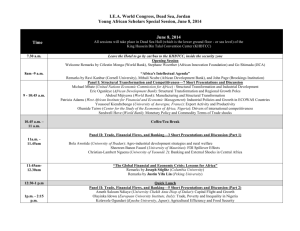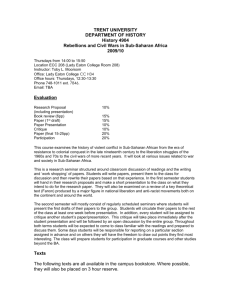Black History Month Presentations
advertisement
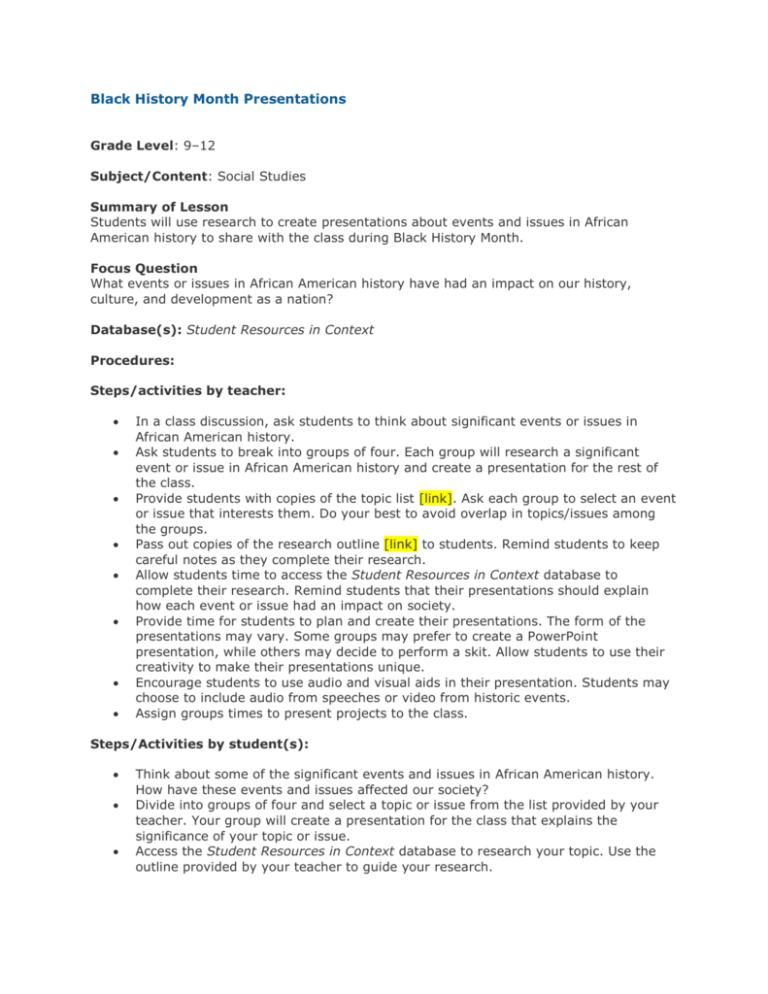
Black History Month Presentations Grade Level: 9–12 Subject/Content: Social Studies Summary of Lesson Students will use research to create presentations about events and issues in African American history to share with the class during Black History Month. Focus Question What events or issues in African American history have had an impact on our history, culture, and development as a nation? Database(s): Student Resources in Context Procedures: Steps/activities by teacher: In a class discussion, ask students to think about significant events or issues in African American history. Ask students to break into groups of four. Each group will research a significant event or issue in African American history and create a presentation for the rest of the class. Provide students with copies of the topic list [link]. Ask each group to select an event or issue that interests them. Do your best to avoid overlap in topics/issues among the groups. Pass out copies of the research outline [link] to students. Remind students to keep careful notes as they complete their research. Allow students time to access the Student Resources in Context database to complete their research. Remind students that their presentations should explain how each event or issue had an impact on society. Provide time for students to plan and create their presentations. The form of the presentations may vary. Some groups may prefer to create a PowerPoint presentation, while others may decide to perform a skit. Allow students to use their creativity to make their presentations unique. Encourage students to use audio and visual aids in their presentation. Students may choose to include audio from speeches or video from historic events. Assign groups times to present projects to the class. Steps/Activities by student(s): Think about some of the significant events and issues in African American history. How have these events and issues affected our society? Divide into groups of four and select a topic or issue from the list provided by your teacher. Your group will create a presentation for the class that explains the significance of your topic or issue. Access the Student Resources in Context database to research your topic. Use the outline provided by your teacher to guide your research. Once your research is complete, meet with your group members to discuss how you will present your findings to the class. You may choose to do a PowerPoint presentation, a skit, or some other presentation. Use your creativity to make your presentation unique. Consider what audio and visual aids would best complement your presentation. Make the final adjustments to your presentation before sharing it with the class. Outcome: Students educate themselves and their peers about significant events and issues in African American history. Related Activities: This activity can be easily integrated with the activities suggested. English Ask students to use their research to create a newspaper article about their event/issue. Students should writer their articles as if the event/issue has just occurred. This activity will allow students to understand how newspaper writing often differs from other forms of writing. Learning Expectation: Students will research events and issues in African American history to understand the impact they have had on American society. National Curriculum Standards for Social Studies High School I. Culture Social studies programs should include experiences that provide for the study of culture and cultural diversity. Learners will be able to: H. Analyze historical and current issues to determine the role culture has played. II. Time, Continuity, and Change Social studies programs should include experiences that provide for the study of the past and its legacy. Learners will be able to: B. Research and analyze past periods, events, and recurring issues using a variety of primary sources (e.g., documents, letters, artifacts, and testimony) as well as secondary sources; validate and weigh evidence for claims, check the usefulness and degree of reliability of sources, and evaluate different interpretations to develop their own interpretation supported by evidence. C. Evaluate the impact of institutions, values, and beliefs of people in the past on important historical decisions and developments and compare different interpretations of the causes and consequences of these decisions and developments. Standard Source: NCSS 2010 ISTE NETS for Students 1. Creativity and Innovation Students demonstrate creative thinking, construct knowledge, and develop innovative products and processes using technology. Students: B. create original works as a means of personal or group expression. 3. Research and Information Fluency Students apply digital tools to gather, evaluate, and use information. Students: B. locate, organize, analyze, evaluate, synthesize, and ethically use information from a variety of sources and media. C. evaluate and select information sources and digital tools based on the appropriateness to specific tasks. D. process data and report results. Standard Source: ISTE NETS for Students, 2007 Information Power; Information Literacy Standards: Standard 1: The student who is information literate accesses information efficiently and effectively. Standard 2: The student who is information literate evaluates information critically and competently. Standard 3: The student who is information literate uses information accurately and creatively. Standard 7: The student who contributes positively to the learning community and to society is information literate and recognizes the importance of information to a democratic society. Standard 9: The student who contributes positively to the learning community and to society is information literate and participates effectively in groups to pursue and generate information. Standard Source: American Library Association, 1998 Topic List Abolition African Americans in: Business Entertainment Politics Religion Science Sports Civil Rights Movement The Dred Scott Case Harlem Renaissance Jim Crow Laws Segregation Slavery The Thirteenth Amendment Tuskegee Experiment Underground Railroad Additional information on the topics listed above can be found in the Student Resources in Context database. Black History Month Research Outline Name ____________________ Hour _____________________ Directions: Use the following prompts to guide your research on your topic or issue. Take thorough notes and put all information in your own words. Use additional paper when necessary. Topic ________________________________________________________________ Brief overview/history of the event/issue: Causes of this event/issue: How the event/issue affected African Americans: How the event/issue affected white Americans: How people reacted to the event/issue: How the event/issue affected society: Long term effects/significance of the event/issue:




